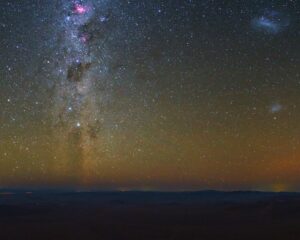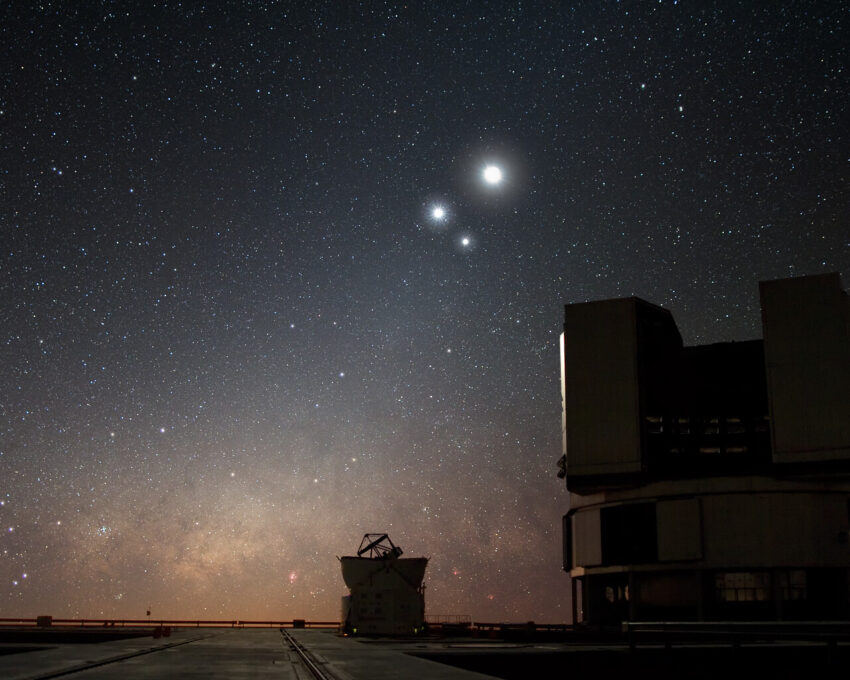Las Campanas, Cerro Telolo, La Scilla, Cerro Paranal – if you’re an astronomy buff, these are familliar names. Cathedrals of astronomy. But these four are simply the best known among many other observatories that are strung like pearls along the crest of the Chilean Andes in the Atacama Desert.  Why are so many of the world’s premiere observatories concentrated in this relatively small area? Simply put, these remote, high mountain tops offer some of the best observing conditions in the world coupled with an excellent support and logistics infrastructure.
Why are so many of the world’s premiere observatories concentrated in this relatively small area? Simply put, these remote, high mountain tops offer some of the best observing conditions in the world coupled with an excellent support and logistics infrastructure.
The Humboldt current runs north along the coast from Antarctica. It creates a permanent temperature inversion – the moist ocean air can’t rise over the coastal mountains. The cloud deck rarely rises over 1,600 meters, so the observatories get 350+ nights of clear skies.
 The air above the Atacama peaks is also extremely stable, giving what astronomers call ‘good seeing’. Think of the shimmer you see looking down the road on a summer day. It’s not what you want when you’re trying to see fine details. The stability of the atmosphere in the Atacama minimizes that problem. Coupled with that, the air above the Atacama is exceptionally dry. This is particularly important in infrared astronomy, since water vapour strongly absorbs infrared.
The air above the Atacama peaks is also extremely stable, giving what astronomers call ‘good seeing’. Think of the shimmer you see looking down the road on a summer day. It’s not what you want when you’re trying to see fine details. The stability of the atmosphere in the Atacama minimizes that problem. Coupled with that, the air above the Atacama is exceptionally dry. This is particularly important in infrared astronomy, since water vapour strongly absorbs infrared.
And the sky in the Atacama is still dark. The region is still remote enough not to be greatly effected by light polution from urban centers. This has become a pressing issue for many observatories in the north. It’s a minor issue in Chile and the government is taking steps to keep it that way.
 The other advantage the Chilean observatories have is that they are new enough to take advantage of the latest technology in optics, sensors and processing. The enormous mirrors of modern telescopes are only possible because they are relatively thin and flexible. One hundred and fifty actuators, behind the mirror make subtle adjustments in real time, to keep the VLT mirrors perfectly focused, despite the changing gravitational stresses as the telescope moves. Combine that with incredibly sensitive CCD’s, laser alignment, AI and more. It adds up to a revolution in astronomy. I was still developing glass plates in a dark room when I studied astronomy, back in the 70’s. I feel like a Neanderthal.
The other advantage the Chilean observatories have is that they are new enough to take advantage of the latest technology in optics, sensors and processing. The enormous mirrors of modern telescopes are only possible because they are relatively thin and flexible. One hundred and fifty actuators, behind the mirror make subtle adjustments in real time, to keep the VLT mirrors perfectly focused, despite the changing gravitational stresses as the telescope moves. Combine that with incredibly sensitive CCD’s, laser alignment, AI and more. It adds up to a revolution in astronomy. I was still developing glass plates in a dark room when I studied astronomy, back in the 70’s. I feel like a Neanderthal.
 The amount of fine detail, the angular resolution of a telescope is directly related to it’s diameter. That’s one reason astronomers want big telescopes. But there are practical limits. However, there is a process called interferometry whereby the light from two or more widely separated telescopes can be combined to act like one giant telescope. In the case of the VLT on Cerro Paranal, the four large (8.2 m) scopes and the five smaller (1.8 m) can be configured to act as a single telescope 130 meters across! This is what gives it the equivalent resolution of being able to see a quarter on the surface of the Moon.
The amount of fine detail, the angular resolution of a telescope is directly related to it’s diameter. That’s one reason astronomers want big telescopes. But there are practical limits. However, there is a process called interferometry whereby the light from two or more widely separated telescopes can be combined to act like one giant telescope. In the case of the VLT on Cerro Paranal, the four large (8.2 m) scopes and the five smaller (1.8 m) can be configured to act as a single telescope 130 meters across! This is what gives it the equivalent resolution of being able to see a quarter on the surface of the Moon.
Interferometry is based on the fact that light is in many respects a wave. It’s not simpling adding the light together to make it brighter. The light waves from two or more telescopes viewing the same object, when precisely combined can either reinforce or cancel each other. The math gets pretty hairy, but the bottom line is that it’s this principle that allows the magic to work. Radio astronomers have been doing this for decades. The longer the wavelength, the easier it is to do and radio waves are measured in meters or centimeters, not nanometers.
 The VLT is doing cutting edge work in infrared interferometry. The universe is a fairly dusty place. In dense nebulae and toward the centers of galaxies, the dust obscures our view. But infrared waves can pass through the dust more easily, revealing details hitherto hidden from view, such as the motion of stars orbiting the supermassive black hole at the center of our Milky Way.
The VLT is doing cutting edge work in infrared interferometry. The universe is a fairly dusty place. In dense nebulae and toward the centers of galaxies, the dust obscures our view. But infrared waves can pass through the dust more easily, revealing details hitherto hidden from view, such as the motion of stars orbiting the supermassive black hole at the center of our Milky Way.
So far, extending this into visible light, whose waves are even shorter, is still beyond our grasp. However I expect that to change in the coming years. And plans are now underway for the European Southern Observatory to build a 39 meter telescope, the tentatively named Extremely Large Telescope on Cerro Amazones, next door to Paranal.
Very exciting, but please guys, work on the name at least a little.

OK, How about the ALT: Astronomically Large Telescope? (Sorry, John…pun definitely INTENDED!)
Ugh! Don’t make me ban you from the comments sections 😉. But seriously, even the theoretical physicists have a little imagination with quarks named ‘strange’ and ‘charm’, thought experiments with dead cats (Schrödinger) and so on. Glad you’re enjoying my ramblings.